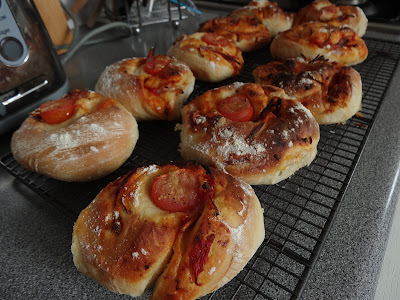For the Dough:
500g Strong White Flour
7g Fast-action Yeast
10g Salt
310ml Water (room-temperature)
1 Tbsp sunflower oil
For the Filling:
Approx. 100g of Cheese (I used mozzarella and taleggio)
3 Tbsp Tomato Sauce (see above)
Half a Red Onion
A Handful of Cherry Tomatoes
1) Weigh out the flour in a bowl, and add the yeast and salt, keeping them separate Add the water, mix, bring the dough together. Add the sunflower oil, and knead for 5-10 minutes. Form it into a ball and leave it in an oiled bowl covered with cling film to rise for 1-3 hours, until doubled in size.
2) Once risen, gently tip the dough out of the bowl onto a floured surface, trying not to knock too much air out of it. Stretch it into a rectangle (approx. 30x20cm). Spread your tomato sauce all over the dough, then place strips of cheese and thinly sliced red onion on top. Roll up the rectangle, keeping it as tight as possible. Once rolled, secure it by sealing the join with your fingers. With a sharp knife, cut the roll at 3cm intervals - you should end up with 10. Place the rolls on a baking tray lined with baking paper, leaving at least 1.5cm between each roll. Put the tray into a plastic bag (a clean bin liner works well) and leave to prove until doubled in size - between 30mins and an hour.
3) Once proved, dust the rolls with flour and push half a cherry tomato (cut side up) into the middle. Bake in a pre-heated oven at 220/200(fan) for 25-30mins. Leave to cool slightly on a wire rack, then tuck in while they're still warm.



























